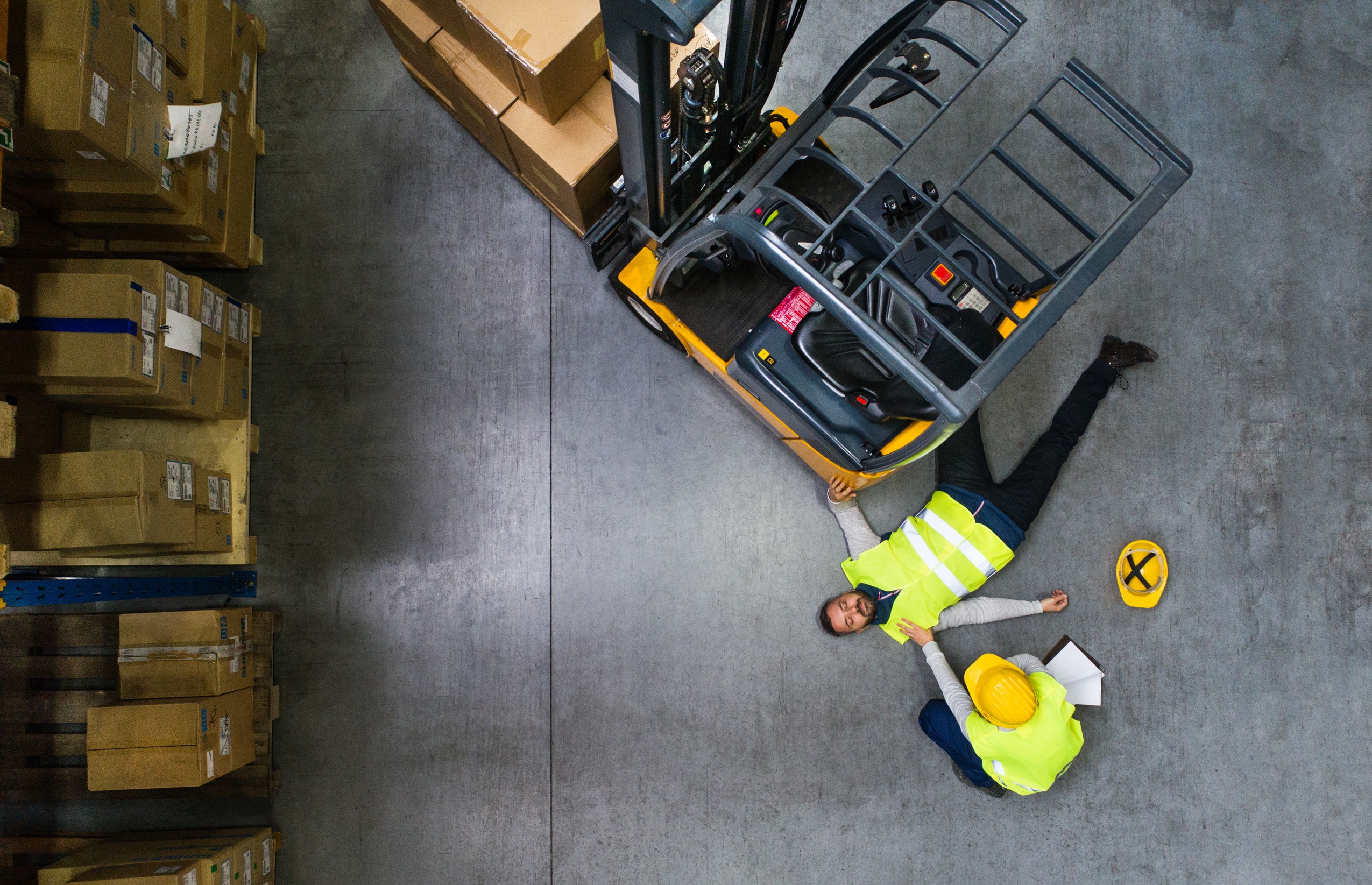Every year, workers suffer preventable injuries because of unsafe or poorly maintained equipment or a lack of personal protective equipment (PPE). If you have been injured in a workplace accident involving faulty or defective equipment, you may be eligible to make a claim for compensation. In this guide, we will explain how long you have to make a defective work equipment claim, what your rights are under current health and safety regulations, and how compensation could help you.
This guide also covers eligibility criteria for making a claim, what evidence might be needed, and some of the most common injuries caused by defective equipment. You’ll also find useful insights on what to do following a defective work equipment accident and what damages you can claim for after an accident at work. Finally, we also discuss the benefits of working with a specialist solicitor from our expert panel.
Have you been injured by defective work equipment and want to know if you’re eligible for compensation? Our expert advisors are here to help. We offer free, no-obligation advice, and can connect you with a specialist solicitor from our panel to help you claim on a No Win No Fee basis. Get started today by:
- Calling us on 0333 0000729
- Using the live chat feature
- Contacting us online
Jump To A Section
- Am I Eligible To Make A Defective Work Equipment Claim?
- How Much Faulty Equipment Injury Compensation Could I Get?
- What Can Compensation Help With After Defective Work Equipment Accidents?
- Is My Employer Responsible For Any Faulty Or Defective Equipment?
- What Types Of Injuries Could Using Faulty Equipment Or Machinery Cause?
- What Should I Do After Being Injured By Defective Equipment At Work?
- Get Free Advice From Legal Helpline
- Frequently Asked Questions
- Learn More
Am I Eligible To Make A Defective Work Equipment Claim?
To be eligible to make a defective work equipment claim, you must meet the following criteria:
- You were owed a duty of care by your employer
- The duty of care was breached due to defective, faulty, or unsafe equipment
- You sustained an injury directly because of that breach
These factors combine to form negligence. But what does a duty of care actually mean?
What Is An Employer’s Duty Of Care?
Your employer has a legal obligation to take reasonable measures to protect your health, safety, and welfare while at work. This duty of care is laid out in legislation like the Health and Safety at Work etc. Act 1974 and the Provision and Use of Work Equipment Regulations 1998 (PUWER). To meet their duty of care, employers can:
- Ensure all work equipment is suitable and safe for its intended use
- Carry out routine inspections and regular maintenance
- Repair or replace faulty equipment
- Provide appropriate personal protective equipment (PPE), like safety boots or a hard hat
- Train staff adequately in the correct and safe use of tools and machinery
Failing to meet these obligations could result in an employer breaching their duty of care. If you were injured as a result, you may be able to claim compensation.
Claiming On Behalf Of A Loved One
Loved ones can claim on another’s behalf if the individual is unable to pursue compensation on their own. In personal injury claims, minors (such as 16 and 17-year-old apprentices) and those who are mentally incapacitated cannot make a claim by themselves. For as long as someone cannot do so, you or another loved one can act as a litigation friend to help claim on their behalf.
If the accident led to a loved one’s death, dependants may be eligible to claim under the Fatal Accidents Act 1976, including for loss of financial support and funeral expenses. However, only the deceased’s estate can claim in the first 6 months of a loved one’s death, per the Law Reform (Miscellaneous Provisions) Act 1934. Qualifying dependants will be unable to claim if the estate has already done so on their behalf through this act.
To discuss making a defective work equipment claim or the role of a litigation friend, please don’t hesitate to talk to our advisory team.
How Much Faulty Equipment Injury Compensation Could I Get?
Various factors can influence how much faulty equipment injury compensation you could receive in a successful claim. The starting point of a claim is general damages, which compensate for pain, suffering, and loss of amenity. This term refers to how your injury impacted your ability to enjoy daily activities, hobbies, and other aspects of your social life.
Solicitors often use the Judicial College Guidelines (JCG) alongside medical evidence to help value this head of claim. The JCG is a publication that lists guideline compensation brackets. You can see some of these below, but please keep in mind that the figures are not guaranteed, and the first entry is not from the JCG.
| Injury | Compensation | Notes |
|---|---|---|
| Multiple severe injuries plus special damages | Up to £1,000,000+ | A combination of multiple severe injuries, including crush or burn injuries, alongside financial losses. These could include the cost of home adjustments or lost earnings. |
| Moderately Severe Brain Damage | £267,340 to £344,150 | There is a very serious level of disability, and the claimant will depend on the care of others substantially, including professionally. The disability might physical (such as limb paralysis), or cognitive. In the latter case, intellect/personality will be markedly impaired. |
| Less Severe Brain Damage | £18,700 to £52,550 | The claimant has a good recovery, and this allows them to participate in a normal working and social life. There may still be a small risk of epilepsy. Additionally, claimant may still have ongoing issues with mood and concentration/memory being poor. |
| Chest Injuries (b) | £80,240 to £122,850 | A serious chest injury affecting the lungs, chest, and/or heart, leading to lasting damage, reduced function, physical disability, and a shorter life expectancy. |
| Below-Knee Amputation of 1 Leg | £119,570 to £162,290 | A straightforward below-knee amputation without complications typically results in a lower compensation amount. Higher awards apply in more traumatic cases—such as when the person was fully conscious during the accident, or when multiple failed surgeries eventually ended in the amputation years later. |
| Loss of 1 Arm (ii) | £133,810 to £159,770 | Amputation above the elbow leading to a shorter stump and difficulties using a prosthetic may lead to higher compensation. Amputation through the elbow usually results in a lower award within the compensation range. |
| Amputation of 1 Foot | £102,470 to £133,810 | Injuries in this bracket will be considered at the same level of amputation of the leg due to the loss of ankle joint. |
| Serious Damage to Both Hands | £68,070 to £103,200 | This bracket comes with serious cosmetic deficit and loss of function that is significant. |
| Eye Injuries (f) | £28,900 to £48,040 | Serious but incomplete vision loss in 1 eye, with the other not at significant risk of lost/reduced vision, or where there is constant double vision. Cases with ongoing blurred vision and light sensitivity in both eyes that require continuous wearing of dark glasses may receive higher compensation. |
| Moderate (i) Knee Injuries | £18,110 to £31,960 | Injuries which include dislocation, or tears in cartilage or to the meniscus, causing a mild disability in the future like weakness, wasting, or instability that is minor. |
How Will My Compensation Be Calculated?
Compensation is calculated through 2 heads of claim: General and special damages. The former head of claim considers factors like:
- The extent and duration of your suffering
- Whether there is long-term or permanent damage
- If your mental health has been affected
Special damages help you recover related financial losses, which we discuss next.
What Can Compensation Help With After Defective Work Equipment Accidents?
Compensation can help ease the financial burdens associated with defective work equipment injuries. You may already know about how quickly costs can add up, especially if you’ve lost income or needed expensive medical treatments. Special damages may help with such costs and other expenses, including:
- Physiotherapy, occupational therapy, and rehabilitative care
- Lost earnings, including in the future
- Equipment, such as electric scooters or assistive technology
- Extra childcare or assistance with day-to-day tasks
- Adaptations to your vehicle or home, such as widening hallways to accommodate a wheelchair
To claim for these and any other expenses, you will need evidence like bank statements and invoices.
Find out more by speaking to our advisory team. They’re here to help and are available 24/7.
Is My Employer Responsible For Any Faulty Or Defective Equipment?
As we’ve discussed earlier, employers are responsible for injuries caused by faulty or defective equipment if they were caused by a failure to meet the obligations laid out by laws, such as:
- Employers’ Liability (Defective Equipment) Act 1969: Makes employers liable for employee injuries caused by defective equipment provided by a third party
- Health and Safety at Work Act 1974: Requires employers to ensure a safe working environment
- Provision and Use of Work Equipment Regulations 1998 (PUWER): Sets standards for the maintenance, inspection, and safe use of work equipment
Will My Employer Have To Pay For My Compensation?
Not directly, as all employers in England and Wales must have Employers’ Liability insurance. This insurance means your employer won’t pay out of pocket for work equipment claims.
To discuss the particulars of your workplace accident, you can reach out to our friendly team today for free, expert advice.
What Types Of Injuries Could Using Faulty Equipment Or Machinery Cause?
Common injuries resulting from faulty equipment or defective machinery include:
- Permanent scars from lacerations and deep cuts
- Crush injuries
- Amputations
- Electric shocks
- Burns
- Eye injuries
- Fractures and broken bones
This list isn’t exhaustive, so don’t hesitate to contact our workplace injury team to talk about your specific situation.
What Should I Do After Being Injured By Defective Equipment At Work?
If you’ve been involved in a workplace accident involving defective equipment, you should seek medical attention immediately. Even if you think your injuries are relatively minor, it’s best to get checked out by a medical professional. You’ll also want to inform your employer about the incident and ensure that it is recorded in an accident book (if there is one).
There are several other steps to consider once you start a defective work equipment claim, which we explore in the following sections.
What Evidence Will I Need To Make A Claim?
You will need evidence that can prove you have a valid defective equipment claim. The following examples are often beneficial:
- Medical reports and any records that can show the extent of your injuries, the treatments you’ve received, and the long-term impact on your health
- Photos showing where the accident occurred and the injuries it caused. For instance, you could take pictures showing the defective work equipment which harmed you
- Contact details for anyone who can provide a statement for your claim. These details can be passed along to a solicitor, who can gather statements on your behalf
- The accident book entry, if applicable
- Maintenance logs or inspection reports
We understand that you may have concerns about the process of obtaining evidence, but the team at Legal Helpline can ensure you get whatever support is required. Our panel of solicitors have the know-how to collect whatever evidence is needed on your behalf and build the strongest claim possible.
How Long Do I Have To Start A Claim?
In personal injury claims, including those involving defective equipment, the time limit is usually 3 years from the date of the accident. This timeframe is set by the Limitation Act 1980, but there are exceptions to the rule. As we mentioned earlier, minors and mentally incapacitated individuals cannot make a claim for themselves. So, time limits are paused unless these 2 groups meet specific conditions:
- Under 18s: The 3-year time limit begins when a person turns 18, giving them until their 21st birthday to start a claim.
- Mental incapacity: There is no time limit unless capacity is regained. If that happens, then the usual 3 years will apply from the point that capacity returns.
If you have a loved one who belongs to 1 of those categories, you can help them to claim while time limits are on hold by acting as a litigation friend. While we’ve already discussed the role, we want to add that any adult can be one, including solicitors, friends, and professional advocates.
Get Free Advice From Legal Helpline
At Legal Helpline, we understand that suffering a defective work equipment injury can turn your life upside down. That’s why our team is here 24/7 to offer confidential and free advice tailored to your unique situation. Whether you’re unsure about your eligibility, need help gathering evidence, or simply want to know about the claims process, we’re here to support you.
We work with a panel of experienced solicitors who specialise in defective equipment claims on a No Win No Fee basis through a Conditional Fee Agreement (CFA). This agreement means you don’t pay a penny in solicitor fees:
- Upfront
- As the claim progresses
- If you don’t get compensation
Contact Us
When you contact us, you’ll speak to a friendly, knowledgeable advisor who will explain your options without any confusing jargon. There’s no pressure, so get in touch to see if you can get the compensation you deserve:
- Calling us on 0333 0000729
- Using the live chat feature
- Contacting us online
Frequently Asked Questions
Below, you can find answers to several commonly asked questions about making a defective work equipment claim.
Can I Still Claim If I Was Partially Responsible?
Yes, you may still be eligible if you were partially responsible for your accident or injury. In such circumstances, claims are settled on the basis of split liability (contributing to an accident) or contributory negligence (contributing to an injury). Your compensation could be reduced proportionally to reflect the extent of your responsibility.
Can My Employer Sack Me For Making A Claim?
No, your employer cannot dismiss you for making an injury compensation claim or having a no-fault accident.
What If The Accident Happened Outside Of The Workplace?
Even if the accident happened away from your workplace, you may still be able to make a defective equipment claim if you meet the eligibility criteria we talked about earlier in this guide.
How Long Will It Take To Settle A Defective Work Equipment Claim?
There is no set timeframe for how long a claim may take, as it can be influenced by many factors, such as the extent of evidence needed and whether a defendant is quick to admit liability.
Will I Have To Take My Employer To Court?
Most work equipment claims settle out of court. The rare instances where a claim goes to court are usually because a defendant refuses to admit liability or the involved parties can’t reach an agreement over compensation during negotiations.
Learn More
For more helpful accident at work guides:
- Find out how to claim for an accident at work caused by oil
- Learn how to claim for a broken arm at work
- Get help making a forklift accident at work claim
Or, for further resources:
- Learn about first aid from the NHS
- Get more information on workplace safety from the Health and Safety Executive (HSE)
- Find out how to request CCTV footage of yourself
Thank you for reading our guide on how to make a defective work equipment claim.
Author
-
Tracy Chick is a dedicated and expert Road Traffic Accident lawyer, holding a prestigious MASS Diploma in her field. When she's not immersed in the complexities of legal cases, Tracy loves to be outdoors, particularly enjoying any kind of water-related activity.
View all posts Road Traffic Accidents Lawyer








